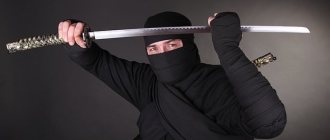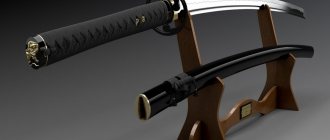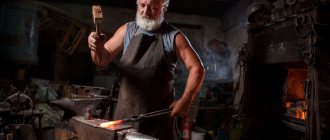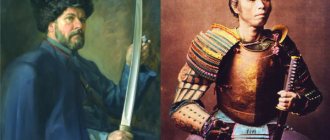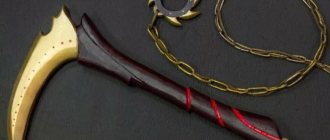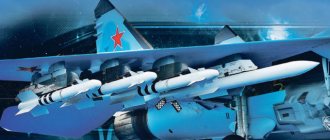Contrary to popular belief, samurai did not disdain teppo (that is, firearms) as an inappropriate and “vile” weapon. More precisely, those who followed tradition and refused gunpowder quickly lost to those who rained lead on the enemy. The Japanese feudal lords loved the new method of eliminating opponents so much that they began truly mass production of arquebuses. Soon their number in this country alone exceeded the number of firearms in all of Europe. And, as is often the case with the Japanese, they have achieved mastery in production. The examples of teppo that have come down to us are real works of art, poetry made of iron, wood, and often gold.
The Japanese word "teppo" refers to an entire class of weapons. Initially, this was the name given to arquebuses of the Portuguese type, which came to the country with the beginning of trade. But since Japanese craftsmen began making gunpowder weapons, its evolution here has followed its own unique path. Over hundreds of years, teppo has acquired its own style and even other functions. Japanese arquebuses became more massive than European ones, and the popularity of hand cannons, kakae-zutsu, generally made local firearms a unique phenomenon.
Victims of bad weather
Most sources agree that the first firearm appeared on Japanese soil in 1543, when a Chinese junk, lost off course due to a hurricane, landed on the shore of Tanegashima Island.
The junk contained three Portuguese traders armed with arquebuses. Old archives say that one of the traders shot a duck, which aroused considerable interest among the then daimyo (governor) of the island. Having quickly negotiated the barrel for the required amount of goodies, and received a couple of lessons in practical shooting, the governor dragged the arquebus to the local blacksmith with a categorical order to figure it out: what the hell is this? And what good can you get out of it? It should be noted that by that time the Japanese already knew gunpowder from the so-called “Mongol expansions”, during which the enterprising Japanese carefully wrote down and sketched everything that seemed useful to them. The problem turned out to be that the gunpowder produced by the Japanese from their own resources was not of very high quality, due to the low content of nitrate in local lands. Therefore, this matter was put on a distant shelf, until better times. And the times have come.
Firearm katana: the strange history of Japanese barrels
When people talk about Japanese weapons, the first thing that comes to mind is the famous katanas. Meanwhile, Japanese firearms have an equally exotic and exciting history.
Firearms appeared in Japan at least a hundred years earlier than in Europe: in the 13th or even 12th century. The proximity to China, the birthplace of gunpowder and the first weapons using it, had an effect. However, the design of this weapon for many years remained the most primitive: a thick-walled metal pipe, capped on one side and having a small hole in the side wall. To fire, either an assistant was required to ignite the gunpowder, or a primitive analogue of a modern bipod, allowing one of the shooter’s hands to be freed. There were no sighting devices, so aiming was carried out “in that direction,” and shooting accuracy was minimal. Of course, the rate of fire was also minimal, so it was impossible to compensate for low accuracy with a high density of fire. This prevented firearms from significantly influencing the way wars were fought, and they were not widely used.
Tanegashima
Development of Japanese small arms: tanegashima
This weapon made it possible to conduct targeted fire, and it could be effectively used by soldiers with a minimum level of training. But the rate of fire and resistance to weather conditions left much to be desired.
Everything changed in 1543: a storm-damaged Chinese junk with two Portuguese travelers on board dropped anchor near the Japanese island of Tanegashima. Before that, no Europeans had been seen on the island, so news of the unusual wanderers reached the local feudal lord. He bought two matchlock guns from travelers and gave orders to understand their design. It was not possible to copy the design completely: Japan did not have the technology for making internal threads, and it was with its help that the breech of the barrel was closed. Because of this, the first inaccurate copies were not very reliable, but they were also so superior to the firearms available in Japan that the whole country soon learned about them. A year later, a Portuguese blacksmith arrived in Japan on another Chinese ship, transferring the technology for making internal threads to the Japanese.
Development of Japanese small arms: murata
Access to modern European developments allowed Japanese gunsmiths to design and produce a rifle chambered for a unitary cartridge, which radically increased the rate of fire, accuracy and resistance to weather conditions.
The seeds fell on fertile soil: feudal wars were raging in Japan at that time, so matchlock guns quickly became widespread. The effective firing range from such a weapon did not exceed 100 m; during the time required to reload it, an experienced archer fired more than a dozen arrows; in the rain, the gunpowder got wet, and the weapon stopped working. But all these shortcomings were compensated by the most important advantage: even such firearms were much easier to master than a bow, so they could arm a large number of poorly trained soldiers. The techniques for handling the new weapons were gradually improved, which increased their rate of fire and accuracy, as well as the weapon itself, which increased its range and resistance to weather conditions. Over the course of two decades, Tanegashima—the Japanese named the matchlock and the weapons with it, after the island—dramatically changed the conduct of war.
Development of Japanese small arms: Arisaka
The talented designer Nariakira Arisaka developed an excellent weapon chambered for smokeless powder cartridges, which, constantly being improved, served the Japanese until the very end of World War II.
Stagnation and development
However, by the middle of the 17th century, Japan had practically done away with feudal wars and switched to a policy of isolation. The absence of major military conflicts and exchange of experience with other countries does not contribute to the development of new military technologies, so the evolution of Japanese firearms has also stopped. Europeans long ago switched from matchlock to much more convenient wheel and impact flintlocks, then to a capsule lock and even a unitary cartridge, and Japan used tanegashima even at the very end of the 19th century - during the Satsuma Uprising of 1877.
Development of Japanese small arms: Type 89
Modern Japanese military weapons are based on Western developments (in this case, on the American AR-18 rifle) and use NATO standard cartridges, and therefore meet all the requirements of our time.
Japanese weapons received another impetus for development in the 19th century. This was facilitated by a general decrease in the level of isolation and, in particular, by the lifting of the ban on the dissemination of Rangaku, a body of European scientific knowledge, in 1803. This made it possible to master the technology of the percussion flintlock. But dramatic changes occurred only after in 1854, the Americans actually forcibly forced Japan to establish political relations, and along with it, trade. And at the same time they provoked a civil war, which, together with the flow of more or less modern foreign weapons of various systems, intensified new Japanese developments. Taking the French Gra rifle of 1874 and the Mauser rifle of 1871 as a basis, Tsuneishi Murata developed the Type 13 rifle chambered for a unitary 11x60 mm R cartridge with black powder, the production of which began in 1880. The Murata Type 13 was the first Japanese weapon in several centuries to correspond to its time.
Meaningful but merciless
In 1937, weapons that had no analogues in the world entered service with the army of the Japanese Empire.
We are talking about the Type 97 anti-tank rifle. It used 20 x 125 mm ammunition, and the weight of the weapon exceeded 50 kg. But that’s not all: originally created precisely as an anti-tank gun, from which they simply shoot from a bipod, this weapon... was not able to shoot single shots - only in bursts! (Only a couple of years later, the Finns created the Lahti L-39 gun, which was similar in parameters, based on an anti-aircraft gun.) The weapon turned out to be very effective against light tanks, in particular against the Soviet BT-5 and BT-7.
Recoil. The presence of high-explosive shells of 20 x 125 mm caliber further expanded the capabilities of the weapon. But, despite the large mass, muzzle brake and other methods of reducing recoil, it still remained simply terrifying. To prevent the shooter from being carried back, the second number of the crew was piled on top of him. Severe bruises were a given, often resulting in broken bones.
In the era of smokeless powder
By the end of the 19th century, Japan, keeping up with Europe, switched to smokeless gunpowder: in 1893, the 9-mm Type 26 revolver, based on the American Smith & Wesson revolver, entered service. And in 1897, the first rifle developed by Nariakira Arisaki, “Type 30”, designed for the new 6.5 x 50 mm cartridge, was put into service. But even taking into account the long barrel, this cartridge was weak by rifle standards. The time for intermediate cartridges had not yet come, and the campaign in Manchuria showed the insufficient power of Japanese rifles. Nariakira Arisaka set about refining his weapon and in 1939 created a new version - “Type 99” chambered for 7.7 x 58 mm. The ballistic characteristics of this rifle already corresponded to the world level, which turned out to be very useful: the Second World War began.
Of course, PM couldn’t miss the opportunity to evaluate Japanese weapons in action and tested a rifle sold under the native Japanese brand Howa 1500. It’s almost impossible to make claims about the hardware. The processing of all parts corresponds to the level of European and American weapons of a much higher price category. The metal surface is smooth, the bluing is uniform, all mechanisms operate smoothly. There are some comments about the “tree”, but it is not made in Japan. If desired, you can order another stock from a wide range for this rifle from the USA. I am glad that the factory holes on the receiver allow the use of sight mounts, originally created for the extremely popular Remington 700 rifle. The design of the rifle is quite common and corresponds to Western canons. The only exception is the placement of a metal drop at the end of the bolt handle instead of the more usual ball. Interestingly, rifles made by Miroku also have a teardrop at the end of the handle. Even for non-professional shooters, it was not a big problem to place four holes in a circle with a diameter of 30 mm at a distance of 100 m. It was more difficult to adjust for the wind: at first, all the bullets were blown sideways from the center of the target (however, the rifle was not to blame for this). If you take into account the wind correction, you can hit a ten-ruble coin from hundreds of meters without any problems. Apparently, in the hands of an experienced shooter, the rifle will be able to show better results. Pros: low price, high quality metal processing, good accuracy. Cons: The stock is not of the highest quality.
But the Japanese pistols of that time could not reach the European level. Created by Kijiro Nambu in 1925, the Type 14, which was the main pistol of the Japanese army right up to the end of World War II, had an outdated and rather complex design that was not very reliable. Its 8 x 22 mm cartridge was much inferior in energy to the 7.62 x 25 mm, 9 x 19 mm and .45 ACP cartridges used in pistols of the Allied armies. The more modern Type 94, which Kijiro Nambu developed in 1934, was intended to be a reliable, inexpensive and convenient weapon, but, alas, it turned out to be poor in all three respects. The pistol could fire itself when the bolt was pulled, the automation worked unreliably, and the price was even higher than that of the Type 14.
Japanese pistol, type 14
The complex design for a cartridge of such power, poor ergonomics and the high price of this pistol forced many officers to buy foreign models at their own expense.
After the war
Having lost the Second World War, Japan found itself severely limited in its ability to develop its armed forces. Perhaps this is precisely what (or maybe there were other factors) that did not allow the Japanese to create competitive pistols and submachine guns. For some strange reason, even after purchasing a license to produce the Mini-UZI in the 1990s, they released a degraded version of it: unlike the original, the Japanese Minebea M-9 does not have a folding stock, which greatly reduces the effectiveness of fire.
But with rifles the situation turned out to be much better. The engineering giant Howa Machinery Co, where the production of Arisaki rifles was established back in 1940, developed the Type 64 automatic rifle in 1964. Although its reliability was not outstanding, the designers managed to achieve acceptable accuracy of automatic fire, despite the overly powerful 7.62 x 51 mm cartridge imposed on Japan (however, the Japanese weakened this cartridge by 20%, but the Type 64 retained the ability to shoot standard cartridges power). In 1989, a 5.56 x 45 mm Type-89 assault rifle, created by the same Howa based on the American AR-18 rifle, entered service.
Japanese pistol, type 94
According to the designer's idea, this pistol was supposed to correct the shortcomings inherent in its predecessor, but in practice it only acquired an additional drawback - the danger of an involuntary shot.
Civilian weapons
Equipped with modern high-precision CNC machines, Japanese engineering enterprises have proven capable of producing very high-quality and competitively priced hunting weapons.
The Model 1500 rifle of the already mentioned Howa Machinery Co (which, in addition to weapons, produces a lot of products - from machine tools to asphalt compactors) has not only a “combat” version, which is in service with the Japanese police, but also a lot of civilians for a variety of calibers, ranging from very from the moderate .223 Remington to the powerful .375 Ruger. Interestingly, the vast majority of 1500s are sold... under other brands! For example, the Weatherby Vanguard, Mossberg 1500 and Smith & Wesson 1500 are all the same Howa 1500. The only difference is in the stock, which each manufacturer makes independently (however, rifles sold under the Howa brand also have a third-party stock). This is due to the circumvention of serious export restrictions in force in Japan.
Another engineering company, Miroku Corporation, produces a wide range of rifles and shotguns for such well-known brands as Browning, Beretta and Winchester.
Unlike Howa, she also does woodworking, so she can mount her weapon in her own stock. Igor Egorov
Japanese "left-handed"
The Portuguese, having finally given the governor a couple of tips on improving the quality of gunpowder, went home, and the blacksmith, in the manner of the Russian Lefty, having conjured a week in the forge, reported to his superiors that he had figured out the “thunder trumpet” and could set up mass production without questions, for which he received “ good" from management. By the way, the same ancient sources claim that this guy was very smart and had engineering savvy, since he managed to slightly modify the firing mechanism of the arquebus, adapting it to the humid local climate. For which he was probably awarded half a liter of sake. Production was quickly established, and according to some sources, when a couple of years later some more gaijins (strangers) came to Tanegashima, about six hundred guns were poked in their noses.
Badze-zutsu Samurai Pistol
In addition to tanegashima, Japanese craftsmen also produced a smaller version of teppo. In fact, it was a local type of pistol, except that it inherited its massiveness from the Tanegashima. The weapon was called badze-jutsu and, just as in Europe, it was most appreciated by mounted warriors who fired a hail of bullets at the enemy before rushing into hand-to-hand combat.
Weapons to the masses
Soon, the production of guns began to spread to other islands of Japan, where the enterprising daimyo sent his traveling salesmen to sell a new product called “teppo” or “hinawa-ju” (match gun). An interesting fact: founded by the Kunitomo family in 1560 in Sakada County (Omi Province), the weapons workshop produced to order magnificent, richly inlaid guns with stocks made of expensive ebony; in mass production, their guns were called udon-ju (noodle guns) , as the barrels bent after several shots.
Light arquebuses and their large counterparts played a significant role in many battles in the country, but in the mid-17th century, Japanese gunsmiths practically stopped mass production of weapons. This happened due to the protest of the samurai, who were not particularly fond of guns anyway, considering them the weapon of the lazy, and then firearms became so widespread that even peasants began to have guns. Proud samurai, who had trained to wield a sword almost all their lives, became indignant at the thought that a farmer unworthy of even seeing a noble blade could simply take an arquebus and demolish a warrior’s tower from 50 meters away. Under the pressure of this and some other facts, the production of firearms in Japan virtually came to naught, again turning the country into a land of swords and spears.
Tanegashima Samurai Musket
Tanegashima is both the Japanese version of the arquebus and the name of the island where trade was carried out with the Portuguese. The weapons adopted from Europeans in the 16th century were initially made according to Western models, but soon Japan developed its own school of artisans and the philosophy of teppo. Perhaps due to the poor quality of iron and gunpowder, local arquebuses became more massive and large-caliber.
Tanegashima in action. This massive monster looks somewhere on the border between an arquebus and a hand cannon:
Standard teppo of the Japanese feudal army:
Samurai followed the code of Bushido
Photo: Richard Mortel / Royal Arsenal Museum, Copenhagen / Wikimedia Commons
It is believed that “Bushi-do”, the way of the warrior, is a certain set of rules governing the life of a samurai. And every bushi should know this code. If he violates it, he will be forced to commit ritual suicide by seppuku, because a warrior must strictly maintain his honor.
In reality, the samurai, of course, had rules of behavior, but they were unwritten. The most complete list of them was compiled by Japanese culture, Hagakure: the book of the samurai in his book “Hagakure” by samurai Yamamoto Tsunetomo. There is just one small but: he was not a bushi, had never seen war, and worked as a manager on the estate of the daimyo Saga.
And Yamamoto wrote down not some unshakable rules, but the memories of old samurai and his own ideas about the ideal warrior. So judging a bushi based on the Hagakure is like judging knights based on courtly novels.
Real samurai's ideas about honor were very different from modern ones. And, for that matter, everyone made their own rules.
Many bushi did not see anything reprehensible in hacking an enemy from behind without announcing the start of the fight.
Fratricide, betrayal, and service to several masters at the same time also occurred among samurai Death, Honor, and Loyalty: The Bushidō Ideal. What can I say, the whole art of battojutsu is dedicated to quickly drawing a sword and killing a person while he suspects nothing - for example, during a tea ceremony. This doesn't really sound like an honest act.
A skilled samurai will stop a katana with a clap of his palms
Still from the film “Ninja Assassin”
Sometimes the military skills of samurai in films and anime are shown in a completely implausible way. So, sometimes experienced bushi manage to stop the blow of an enemy’s katana by holding it between two palms. It looks very cool, but completely unrealistic.
In general, in different schools of fencing - both Japanese and European - there were techniques that made it possible to take a sword from an opponent. But before grabbing a weapon by the blade, it is highly advisable to put on bracers and thick gloves. The blade is not touched with bare hands - you can only grab the handle or the opponent’s hands.
It is simply impossible to stop the blow of the blade with a clap of your palms - you will simply be mutilated or your limbs will be completely cut off.
Parts of tanegashima[ | ]
- Shiba-hikigane - butt protection
- Hikigane - trigger
- Karakuri Castle
- Dziita - stove
- Yuojintetsu - trigger guard
- Biyu - rivet
- Hinawa Toshi Ana - wick hole
- Hajiki Gane - spring
- Dugane - butt ring
- Hibasami - spring
- Amaoi - barrel protection
- Hibuta - powder flask lid
- Hizara - powder shelf
- Give me the butt
- Tsutsu - trunk
- Moto Maete - sight
- Udenuki - belt hole
- Naka Maete - rear sight
- Mekugi Ana - pin hole
- Saki Maete - fly
- Karuka - ramrod
- Suguchi - barrel
Seppuku is the best end for a samurai
Illustration: Kunikazu Utagawa / Public Domain / Wikipedia Commons
A samurai who lost his dignity, in theory, certainly had to commit ritual suicide by seppuku. It consisted of the following: the bushi dressed in white, wrote farewell poems, then knelt down and ripped open his stomach with a short kusungobu blade. This should have been done without hesitation and with a straight face.
And the samurai’s comrade, called kaishaku, must cut off his head, but not completely, but so that it hangs on a piece of skin. If a kaishaku's head is cut clean off through negligence, the samurai will be covered in shame. If the samurai held firm, his stomach was ripped open correctly and his head was cut off immaculately, then his honor was saved.
It sounds creepy, but in fact, hara-kiri Suicide and culture in Japan: A study of seppuku as an institutionalized form of suicide, Samurai invasion: Japan's Korean War, 1592‑98 in most cases was done not to save honor, but to avoid even greater troubles . For example, if a samurai was defeated in battle and was threatened with capture and torture, he chose the quicker end, which also helped save face.
Quite reasonable, given how brutally the samurai treated their prisoners—burning, crucifixion, and boiling were commonplace. A particularly unlucky person could be sawed in half... with a wooden saw.
And for samurai who had disgraced their daimyo, seppuku was sometimes the only way to preserve property.
After all, if a bushi rips open his belly, his fortune will be passed on to his heirs. And if he is tried and sentenced, his property will be confiscated.
Finally, painful hara-kiri, according to the rules, was not done very often. If the samurai understood that death was inevitable, he could ritually touch his stomach with a fan. Suicide and culture in Japan: A study of seppuku as an institutionalized form of suicide, without suffering, falling out entrails and blood. And the kaishaku quickly beheaded him.
Photo: DopefishJustin/The Rev. R.B. Peery, A.M., Ph.D. / Fleming H. / Revell Company / Wikimedia Commons
And in addition, if the samurai daimyo died or committed hara-kiri himself, the bushi did not have to follow his example. He could go to a monastery and live there - this was considered an acceptable alternative to seppuku. Or you could give up the rules a little and find yourself a new master.
Kakae-jutsu Samurai hand cannon
The evolution of teppo has led to unexpected results. Thus, hand cannons called kakae-zutsu or o-zutsu gained great popularity. Of course, hand mortars were also in use in Europe, but there they did not receive such love and distribution as in Japan. Tanegashima is not enough for a real samurai; he wants to fire at the enemy from a cannon while holding it in his hands!
And here you can see how a rocket is inserted into the barrel of the kakae-zutsu. She will either explode in her hands or give a gunpowder wake to the enemies of the daimyo.
Weapon with wheel lock
Leaders in weapon evolution who are not yet striving for laurels are Free Brand
.
The creators of the wheel castle, in the strictest secrecy from the rest, are creating and training the newest branch of the military. Mounted riflemen using firearms. They called them reitars
. It includes exclusively rich and noble warriors who are able to buy themselves truly unique large double-barreled pistols with a wheel lock. So far their main problem is the small number. Of course, in their country there are also arquebuses, which are much less common than in the Paranian Union or in the Piraeus Kingdom. However, if the idea with the reiters justifies itself, then they will still have their say.
Arquebus
A more advanced, but at the same time, also quite simple lock (gunpowder ignition device). Instead of a simple hole in a tube sealed on one side, we have a hole leading to a special shelf, and next to it is an S-shaped squiggle, which is a trigger on one side, and a wick holder on the other. We press the trigger, the wick pokes into the shelf with gunpowder and fires a shot. Another important difference from the hand-held rifle is the presence of a full-fledged butt and stock, as well as simple sighting devices. Thanks to the ergonomic butt and not too much weight (2.5-3.5 kg), the arquebus allows for more or less accurate fire. The average shooter (Specialist) is quite capable of placing a bullet into a target measuring approximately 80 by 80 cm at a distance of up to 100 meters. Bullets are usually cast around 15-17mm. Armor up to 2 mm thick can penetrate at a distance of approximately 30 meters.
